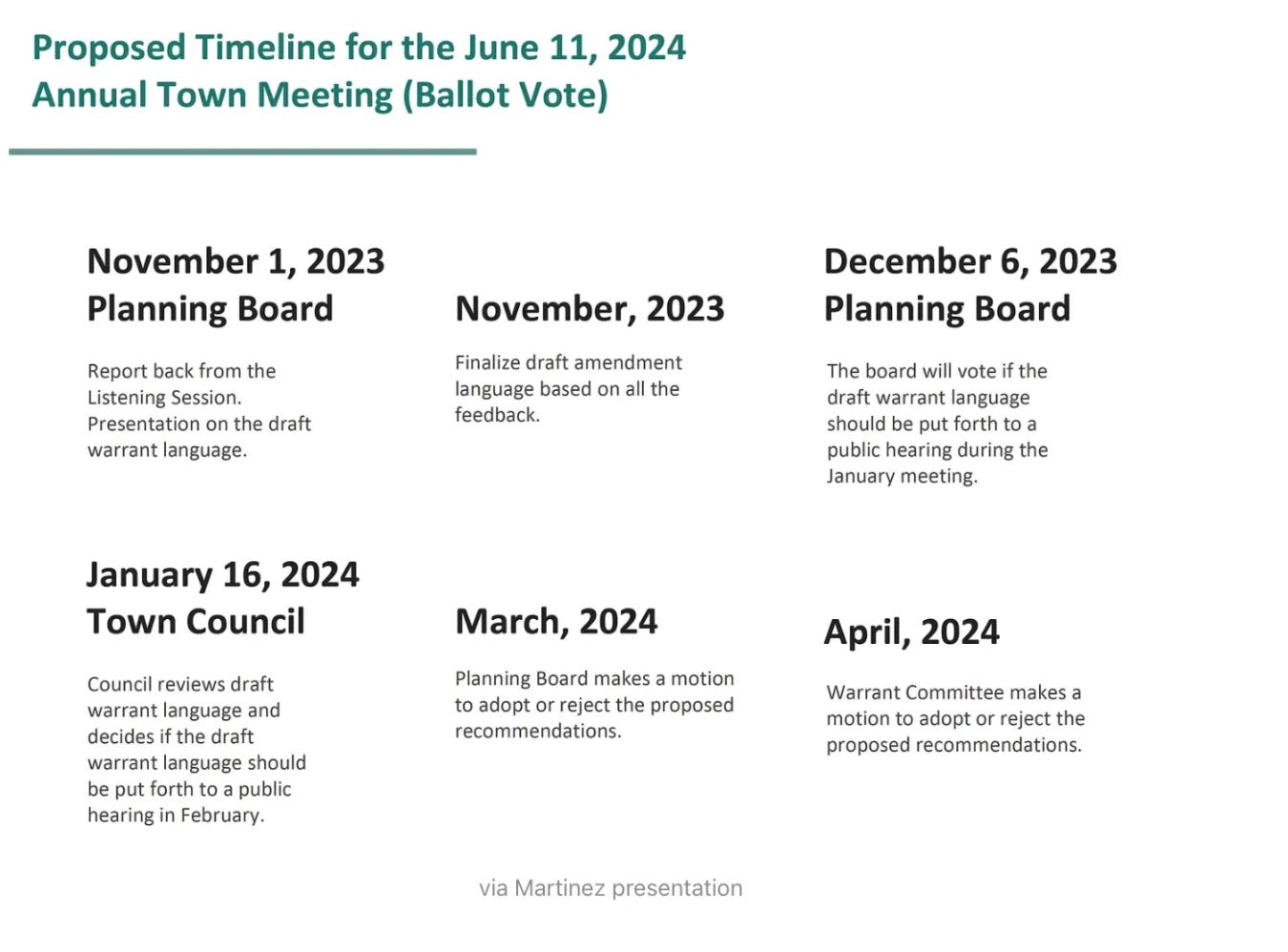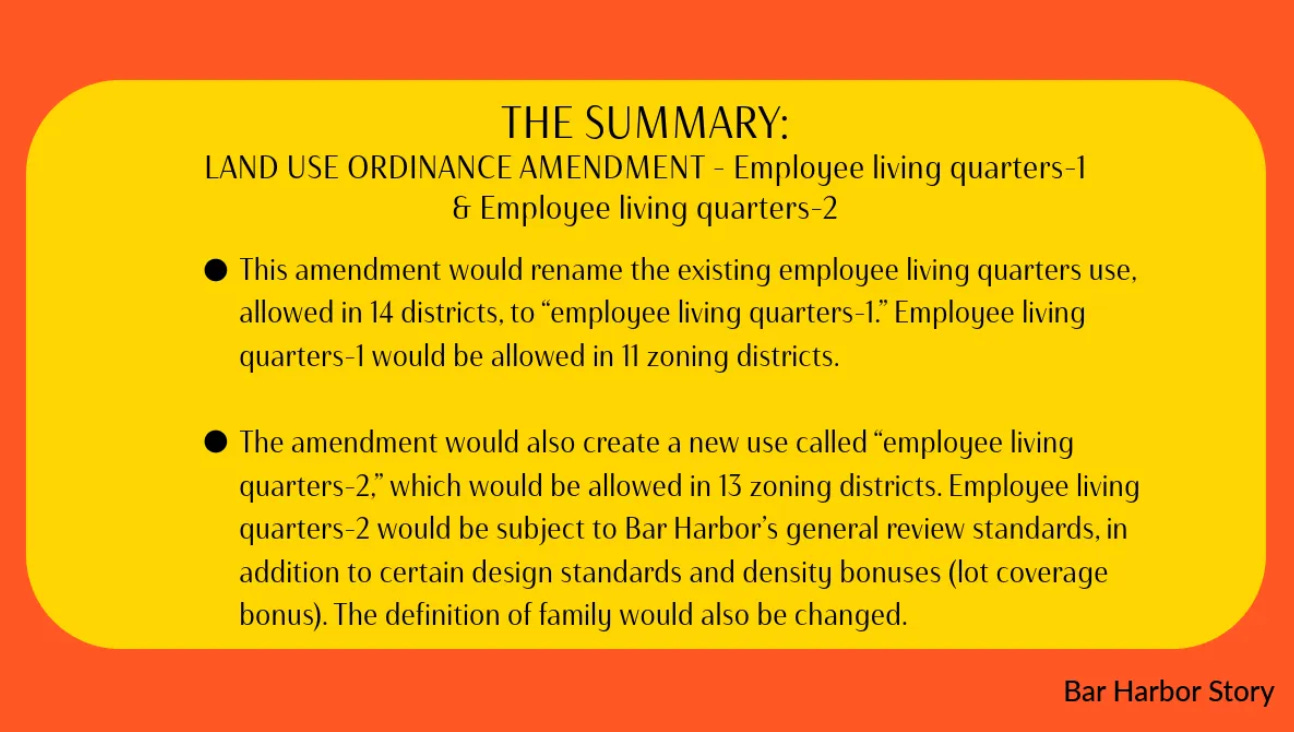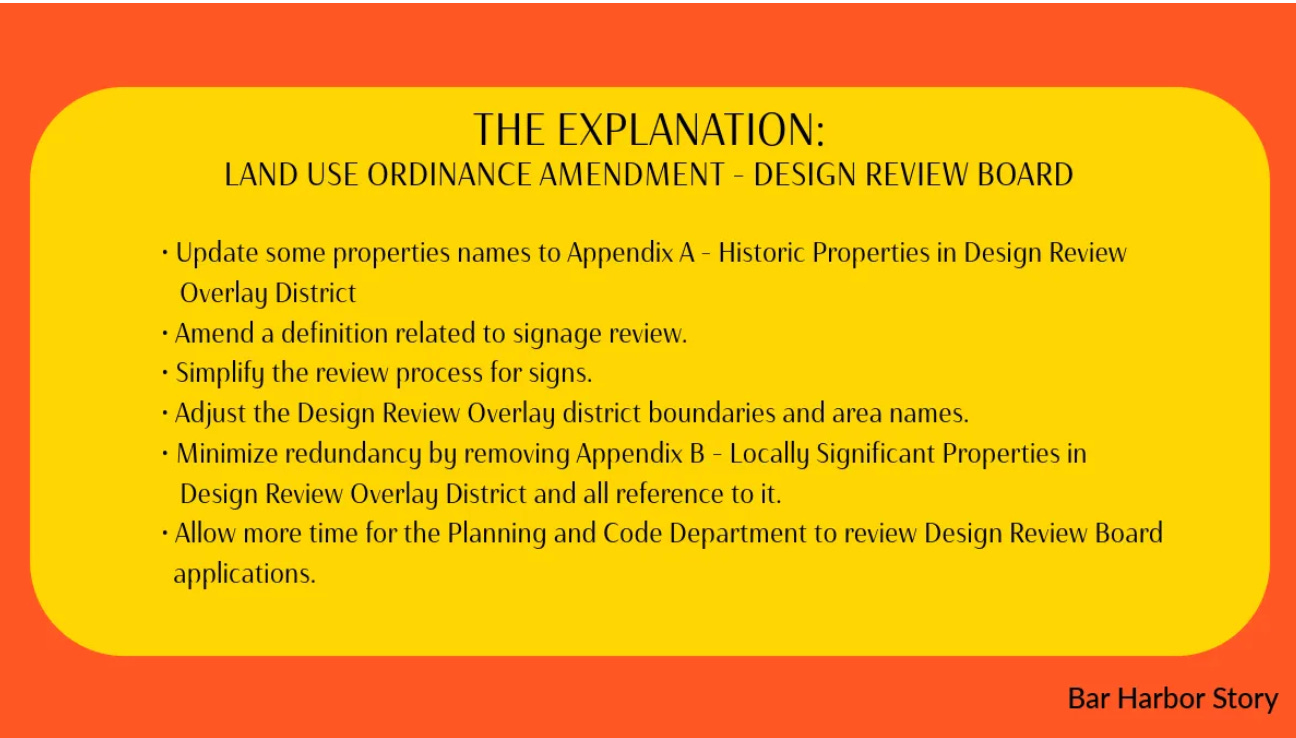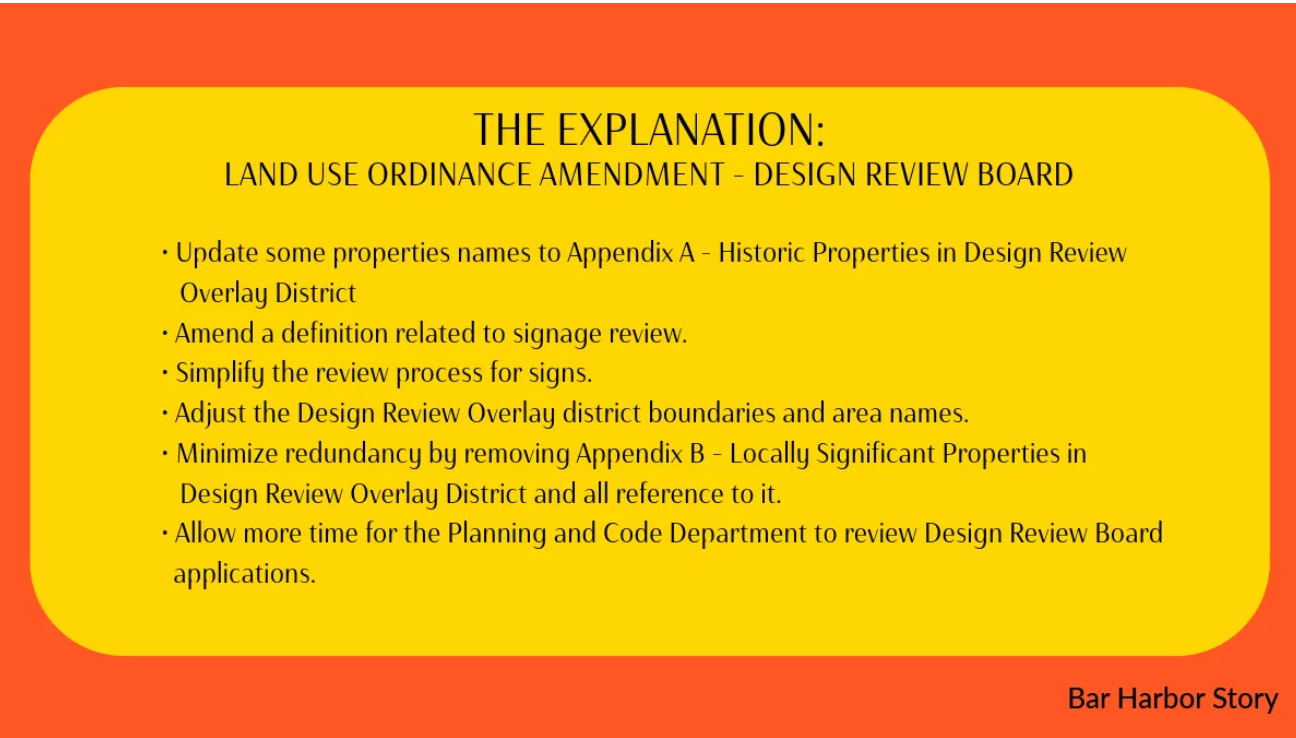Potential Changes to Bar Harbor Housing Rules Head to Public Hearing
Another potential amendment hopes to fix inconsistency about residency voting requirements on boards and committees
BAR HARBOR—At its January 16 meeting, the Town Council unanimously moved five potential amendments to the town’s land use ordinance (LUO) to February 20 public hearings. The amendments deal with allowing additional housing uses in rural developments, trying to rid the ordinance from inconsistencies.
The land use ordinance regulates how real estate is used and developed.
WHAT ARE LAND USE REGULATIONS?
The LUO separates Bar Harbor into approximately 40 differently zoned districts. According to FindLaw,
“The basic purpose and function of zoning is to divide a municipality into residential, commercial, and industrial districts (or zones), that are for the most part separate from one another, with the use of property within each district being reasonably uniform. Within these three main types of districts there generally will be additional restrictions that can be quite detailed—including the following:
Specific requirements as to the type of buildings allowed,
Location of utility lines,
Restrictions on accessory buildings, building setbacks from the streets and other boundaries,
Size and height of buildings,
Number of rooms.
“These restrictions may also cover
frontage of lots,
minimum lot area,
front, rear, and side yards,
off-street parking;,
number of dwelling units.
“Regulations may restrict areas to single-family homes or to multi-family dwellings or townhouses. In areas of historic or cultural significance, zoning regulations may require that those features be preserved.”
To change the regulations, Bar Harbor has specific processes. For the amendments discussed at the Town Council meeting, the process involves at least one more public hearing and ends in town voters determining each amendment’s fate this June.
THE AMENDMENTS
There are four proposed amendments that came through the Planning Board and were worked on by the Planning and Code Enforcement Office: employee living quarters; shared accommodations; housing opportunities, and the Design Review Board process and definitions. Another amendment is meant to deal with inconsistencies in the Boards, Committees, and Commissions Ordinance.
The council unanimously moved all the amendments to a February 20 public hearing.
COMMITTEE INCONSISTENCIES AMENDMENT:
Town Clerk Liz Graves said that the town realized that there were some inconsistencies about voting members needing to be residents on two of the committees, Parks and Recreation and Communication and Technologies. The language has to be adjusted so that it can be consistent that voting members are residents of Bar Harbor.
The changed amendment’s move to public hearing coincided with Councilors Kyle Shank and Matt Hochman giving an update about their work to review the town’s many committees, boards, task forces, and working groups. The councilor duo was tasked to do this review in 2023.
Shank said that he and Hochman have been looking for opportunities for consistency, better wording, or better processes.
When it comes to standardizing definitions, even the terms committees, boards, task forces, and working groups aren’t defined, he said.
They are also looking into standardizing committee composition such as committee or group or task force sizes.
Additionally, formalizing the relationship between committees and town staff and Town Council is part of their review.
“Making sure committee members feel heard and powerful to the extent that is permissible” is the goal, Shank said.
During the council meeting, Task Force on the Climate Emergency member Brian Booher thanked Shank for bringing that relationship up. He said that the task force makes recommendations and wonders if those recommendations make it to councilors. He said the task force could use support.
Shank and Hochman are also looking into ways to potentially standardize how boards are dissolved. Task forces like the Parking Solutions Task Force often have end goals. The Parking Solutions Task Force end goal was met, but that was ignored and the task force still exists, Shank said.
Planning Board Vice Chair Ruth Eveland said that the Planning Board has discussed the excused absences votes at the Planning Board because there is nothing in the board’s language about it.
“Right now each committee has their own bylaws and we have dis-conglomeration,” Shank said. This extends even to what committees and boards have council representatives rather than others. Part of their effort is to have board and committees have consistent expectations for members. “We really want to gain consistency across all boards, committees, task forces, working groups.”
Council Chair Valerie Peacock said that the duo’s work is also linked to the conversations about Ethics Ordinances and that the consistency Hochman and Shank spoke about would help with the ethics conversation.
“We’re going to get back together and start moving things forward,” Hochman said of the work.
The order writes,
“WHEREAS, the Boards, Committees, and Commissions Ordinance was amended following a 2018 citizen initiative to require that voting members of boards, committees, and commission be residents of Bar Harbor, and the ordinance was subsequently further amended to clarify this requirement; and
“WHEREAS, the requirement created possible inconsistencies in two sections of the ordinance, the two committees whose members need not be Bar Harbor residents, Communication and Technologies Committee and Parks & Recreation Committee; and
“WHEREAS, an amendment is proposed to correct this inconsistency and clarify quorum requirements in these two committees;
“NOW THEREFORE, BE IT ORDERED, that a public hearing is now scheduled for February 20, 2024 at 6:30 p.m. for public comment and possible adoption of Ordinance Amendment 2024- 01, ‘An amendment to the Boards, Committees, and Commissions Ordinance to correct inconsistencies.’”
LAND USE AMENDMENTS AND WHETHER OR NOT COUNCILORS CAN CHANGE THEM AFTER PUBLIC HEARING
Exactly how much the Town Council can change the wording of proposed land use amendments after a public hearing and the process for doing so is still being investigated by the town’s attorney.
Councilor Earl Brechlin asked if changes to the proposed amendments can be made at the February 20 public hearings. Town Attorney Stephen Wagner said that question has been wrestled with in Bar Harbor’s past and that the attorneys will be issuing written guidance on that and for now he wants to defer his answer. They can, he said, make changes, but they will discuss how that can affect the process.
Council Vice Chair Gary Friedmann said that there are some people in Town Hill who are not happy with some of the proposed changes and that it’s important for the councilors to know going into that meeting what is possible and what is off the table in regard to changes. In early January, some Town Hill residents spoke to the Planning Board about their worries about allowing employee living quarters and shared accommodations in some of the town’s more rural areas.
Charles Sidman commended Brechlin and Friedmann for asking about the Town Council being able to potentially tweak the ordinances and said that it’s not a pro-forma exercise that the version will pass and head to ballot. “I think it’s really important that you can make changes if you so deem after the public hearing.”
At the same time, Wagner explained that the language and style that the Town Council sees in its packet and its motions have changed a bit.
On January 16 Wagner via Zoom summarized the procedural context at the Town Council meeting.
“We are styling things a little bit differently,” he said.
Each of the four action items are amendments initiated by the Planning Board. They are each a separate motion to be moved to public hearing. That public hearing will then be followed by Council consideration to put the potential changes on the ballot. The Planning Board will also have a public hearing and vote to recommend or not when the item is on the ballot. Voters will see those recommendations, much like they see the Warrant Committee’s recommendation on budget items.
The purpose, Wagner said, is to make sure that the procedural history and legislative intent is clear. He also stressed that the public has already had numerous opportunities to comment on the potential LUO changes and will have more in the future.
At the Tuesday night meeting, he suggested councilors not dive into a debate on the merits of the amendments and that any questions be directed to planning staff and Planning Board so that they can work on those questions and present on them at the public hearing on February 20. At that meeting, the Council will accept or reject the amendments or potentially tweak them.
THE ACTUAL AMENDMENTS:
According to a notice of public hearings, the employee living quarters amendment “would rename the existing employee living quarters use, allowed in 14 districts, to “employee living quarters-I.”
Employee living quarters-I would be allowed in 11 zoning districts. The amendment would also create a new use called “employee living quarters-2,” which would be allowed in 13 zoning districts. Employee living quarters-2 would be subject to Bar Harbor’s general review standards, in addition to certain design standards and density bonuses (lot coverage bonus). The definition of family would also be changed.”
According to that same notice for shared accommodations, “This amendment would increase housing opportunities by allowing more types of shared accommodations in 10 zoning districts where that use is not currently allowed. Shared accommodations is a housing type that includes individual rooms with shared dining facilities.”
“Housing Opportunities: This amendment is necessary to comply with LD 2003 and LD 1706. It is part of a statewide effort to increase housing units by requiring municipalities to remove some regulatory barriers to housing production. It allows for a density bonus of 2.5 times the base density for affordable housing developments in certain areas. It generally allows between two and four housing units per lot where housing is permitted, as well as allowing accessory dwelling units to be located on the same lot as a single-family home, under certain conditions.
“Furthermore, the amendment would delete Bar Harbor’s ‘bonus dwelling unit’ use because LD 2003 requires a comparable but more permissive use, referred to as accessory dwelling units. The amendment would also prohibit dwelling units expressly created under these provisions to be registered and/or used as short-term rentals.”
Design Review Board process and definitions
“This amendment would:
Update some properties names in Appendix A — Historic Properties in Design Review Overlay District;
Amend a definition related to signage review;
Simplify the review process for signs;
Adjust the Design Review Overlay district boundaries and area names;
Minimize redundancy by removing Appendix B — Locally Significant Properties in Design Review Overlay District and all reference to it;
Allow more time for the Planning and Code Department to review Design Review Board applications.
LINKS TO LEARN MORE:
A much more detailed explanation of the four land use ordinances (with maps and images) is linked below.
Building Between a Ledge and A Wet Place
BAR HARBOR—Concerns about water use, sewer capacities, and nitrates as well as the re-purposing of potential employee living quarters in many zoning districts dominated the Planning Board’s public hearing on Wednesday, June 3, about multiple potential land use ordinance amendments that deal with adding specific types of housing uses in different areas i…












